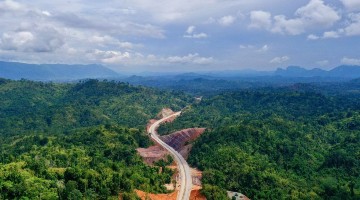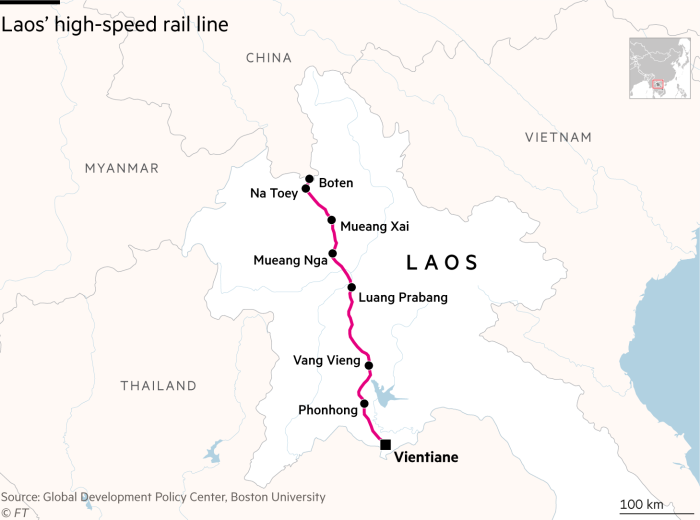The FT reports ahead of tomorrow’s opening with commentary from Andrew on LinkedIn where the link is no longer current so here are both pieces:
FT re Laos rail 2 Dec 21
Laos will open a $6bn Chinese-built railway on Friday, the biggest public works project in its history, which analysts warn could expose the poor south-east Asian country to financial risk or political coercion from Beijing.
The 414km line, which runs from Boten, near the Chinese border, to the capital Vientiane, has been constructed under China’s Belt and Road Initiative, Xi Jinping’s signature infrastructure programme. Laotian officials hope the railway will cut freight costs, boost exports and usher in more foreign tourists once the Covid-19 pandemic subsides and borders are reopened.
Chinese companies have bored 75 tunnels, built a bridge across the Mekong river at the city of Luang Prabang and levelled swaths of rugged terrain to connect landlocked Laos to the Chinese provincial capital Kunming and ease the country’s access to global markets.
But analysts warned the project represented a gamble for the heavily indebted country of 7m.
“There are potential positives to the project,” said Jeremy Zook, director of Asia-Pacific ratings with Fitch Ratings. “The downside is that this is a very expensive railway, so the question is whether these upsides are enough to make full economic sense in terms of the cost-benefit.”
As in the case of some BRI projects — notably a Chinese-built port in Hambantota, Sri Lanka, that was leased to China after Colombo struggled to service its debt — analysts have questioned whether Laos will be able to manage its finances.
“This is one of the main concerns I have: how they will service the debt,” said Ruth Banomyong, professor of logistics at Thammasat Business School in Bangkok. “High-speed rail has always been questionable economically.”
The railway’s construction costs were equivalent to almost a third of Laos’ GDP. Of that amount, Lao-China Railway Company, the special purpose company building and running the railway, has borrowed $3.54bn from China Eximbank.
The LCRC has Chinese and Laotian state-owned companies as its shareholders, with a 70:30 per cent Chinese-Laotian ownership split.
To finance its equity stake, Laos borrowed $480m from China’s Eximbank and contributed another $250m of its own funds, in addition to covering the costs of resettling villagers along the railway route.
But researchers affiliated with the AidData lab at William & Mary university in Virginia said in a recent report there was a “non-trivial possibility” that Laotian or Chinese authorities would feel compelled to bail out the LCRC if it were to default on its obligations to the bank because the railway is a public infrastructure asset.
Recommended News in-depth Belt and Road Initiative Laos’s Belt and Road project sparks questions over China ambitions Laos already has to repay an average of $1.3bn in public external debt service annually until 2025, according to the World Bank, after borrowing heavily to finance power and other infrastructure projects. Its total debt last year reached $13.3bn, or 72 per cent of GDP, as the government relied on borrowing to finance energy and other projects.
The World Bank recently warned that the country’s external debt distress remained high and its foreign exchange reserves low, at about $1.2bn as of May.
Laos ceded majority control of its electric grid last year to a Chinese company as it struggled to avoid a default, according to Reuters.
“Their sources of financing are becoming more limited, so there’s going to be a challenge in terms of being able to repay and refinance some of their upcoming obligations,” said Zook. Fitch has given Laos a sovereign rating of triple C, indicating that “default is a real possibility”, he added.
AGK commentary thereon on LinkedIn
In Laos, today is National Day to commemorate the founding by the Pathet Lao in 1975 of the Lao People’s Democratic Republic. Tomorrow, a new rail link from Vientiane via Luang Prabang to the northern border with China opens, built by Chinese companies under the Belt & Road Initiative.
The rail link was built quickly as it is unlikely that the local population was consulted or compensated much. It is no doubt an impressive piece of engineering and it should transform Laos’ trade with China. However, extending southwards requires a bridge over the river to Nong Khai in Thailand then track down to Bangkok and the coast which may not be completed by the Thais until 2028.
More immediate is the rail link’s financial viability. Taking into account the 60% project debt, China’s 70% of the equity and its loan to Laos to fund the latter’s 30% of the equity, China has contributed 96% of the $6 billion cost. Traffic forecasts for the rail link, if they exist, are unlikely to show that it can service this sort of financial burden even if you include the external benefits such as the increase in value of land accessible to stations. But if this is another Hambantota in the making, whose problem is it then? Laos has already ceded control of its electricity grid to China. I expect that both governments made their calculations long ago.








